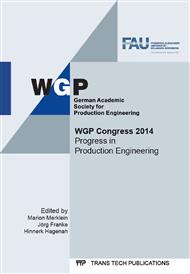p.153
p.161
p.167
p.175
p.183
p.189
p.199
p.207
p.215
Modelling of Tool Engagement and FEM-Simulation of Chip Formation for Drilling Processes
Abstract:
Drilling is the most used machining operation in modern manufacturing. Consequently, a high efficiency is desired which can achieved by proper tool geometries and process conditions. The claim for a high degree of process understanding is met by the attempt to visualize the chip formation on a micro scale, e.g. by the use of the finite element method. While two-dimensional FE-simulations of cutting processes are established 3D is the next step to take for further analysis of the drilling processes. Nevertheless, this puts high challenges to the simulative approach in order to achieve valid results. This paper deals with the modelling and the simulation of drilling operations with respect to tool and workpiece geometry. In order to create an acceptable starting condition it is useful to consider the engagement situation of the tool and the workpiece as an ideal state with a defined uncut chip thickness in front of the cutting edge. This provides shorter calculation times due to earlier steady-state chip formation compared to simulations with workpieces which are modeled with uniform surfaces like planes or cones in the initial state. Therefore, the engagement situation is created by the utilization of a geometric-kinematical modelling technique in which an array of rays and their intersections with a triangular mesh constitute a discrete description of a surface. The obtained set of points is further used for triangulation to generate the workpiece geometry mesh. Finally, finite element simulations of the drilling processes are carried out and are analyzed with respect to drilling torque and feed force.
Info:
Periodical:
Pages:
183-188
Citation:
Online since:
September 2014
Authors:
Keywords:
Price:
Сopyright:
© 2014 Trans Tech Publications Ltd. All Rights Reserved
Share:
Citation:


